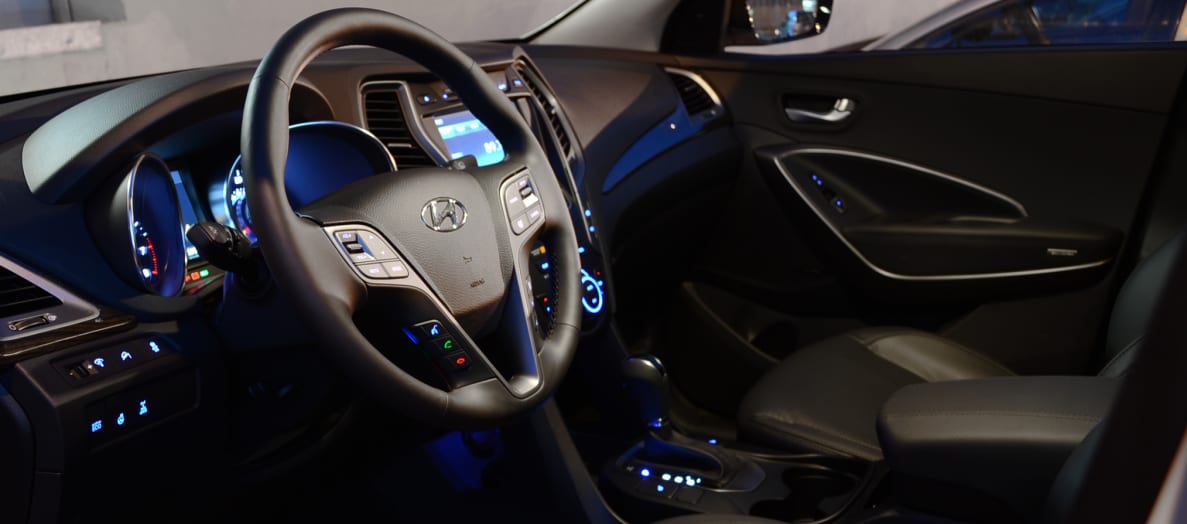Introduction
We got to drive both. Each has its distinct purpose, but considering price and features we predict both will be very competitive in the crowded field of crossovers. Connectivity lags behind when it comes to entertainment—there aren't any apps you can download, or music sources you can stream—but the Blue Link telematics suite at least gives GM's OnStar a run for its money.
Tech & Entertainment
Not much entertainment-wise, but safety and security are spoken for
Fully optioned out, the Santa Fe comes with navigation and Hyundai's BlueLink telematics system. Missing are third-party apps or the ability to piggyback off a smartphone's data connection. Still, Hyundai's navigation and infotainment system generally works quite well, offering up numerous choices for finding a radio station or a restaurant. Our only complaint is that, on the Santa Fe's dashboard, all those options added up to needless complexity.
Rather than putting the most frequently used selections at a driver's fingertips, Hyundai put all possible options on the screen at all times. Want to search for a hot new restaurant by its latitude and longitude? There's a button for that, and it's on the home screen. Where most nav systems let users search by "previous," the Hyundai offers three separate choices: "Previous Destinations," "Previous Searches," and "Previous Start Points." There are separate physical buttons for "Route," "Map" and "Destination." You, Hyundai, win the Award for Redundancy Award.
Aside from needless duplication, one particularly interesting optional feature from Hyundai is Blue Link, a telematics suite that uses two layers of voice recognition for hands-free inputs. Press the Blue Link button on the car's rear-view mirror and the car's voice recognition software will try to decipher what you've said. If it can't understand you, it'll pass you off to a real, live human being. While there's definitely a learning curve when it comes to what selections to make (who knew there's a difference between sending an address to the navigation and actually setting it as a destination?) it's an interesting concept. I used BlueLink quite successfully while driving in stop-and-go traffic, guided only by the half-remembered name of an Italian restaurant that my passenger swore was "right off the highway," somewhere near Manchester, NH. BlueLink found it, no problem, and connected us with the maitre'd in order to make a reservation. If only our waiter had been as helpful.
Like GM's OnStar, Blue Link also can also notify the authorities in the event of a crash or if your vehicle is stolen. You can also lock and unlock doors, find your Hyundai, and look at vehicle diagnostic information on your smartphone or on the web. Also like OnStar, Blue Link requires a subscription—$79 a year for basic features including collision notification, $179 a year for the same features plus stolen vehicle recovery and some other security-related options, and $279 a year to add navigation, restaurant ratings, and more.
{{photo_gallery "tech"}}
Design
Seats five, six, or seven
Where the prior Santa Fe blended in, each new model stands out. Until now, the crossover featured an anonymous bulbousness, less design language than shorthand. For 2013, however, designers pinched the corners, raked the windows and added an oh-so-trendy trapezoidal grill. It's sleeker and more aggressive, and the Sport is somewhat reminiscent of the new Ford Escape. The GLS and Limited replace the Veracruz. Each has a longer wheelbase, bigger rear windows, and room for six or seven depending on seating configuration. That rearmost seat is for kids only, by the way. It sits very low to the ground, and the middle seats don't slide forward far enough for easy egress.
Inside, it's clearly a Hyundai. You can tell from the dashboard air vents, which are the same regardless of whether the car is an Accent or an Equus. Luckily, Hyundai's trademark chunky controls—ones that are easy to press but still blend into the interior—are still there. There's just enough wood trim to be tasteful, plus some plastics with interesting textures. The heated leather seats proved comfortable on a long trip, and on the Sport there was also plenty of room for cargo with the rear seats up or down. Pack rats will appreciate multiple cubbyholes and cupholders. We were big fans of the optional panoramic sunroof, which made a drive through a big city a lot more scenic for backseat passengers.
{{photo_gallery "design"}}
Driving Experience
Great engines, lousy steering feel
On vehicles equipped with Hyundai's gasoline direct injection (GDI) engines, some of the best tech is under the hood. We'll spare you the details, but we assure you it's a good way to get a lot of power out of a small engine. Like a Subway sandwich artist squirting exactly a tablespoon of honey mustard on your footlong, Hyundai's GDI doles out juuuust the right amount of gasoline in exactly the right place: no more, no less. Other improvements ensure the engine works as hard as possible, and the benefit is clear. On the four-cylinder Santa Fe Sport, were it not for the badge on the rear of the car, it would be impossible to tell that this big crossover has a lowly four-cylinder engine.
On our highway-heavy test drive, the Sport's fuel economy averaged in the low-20s, which isn't tremendously impressive, but not too bad for a heavy crossover with all-wheel drive. Expect fuel economy in the mid-teens if you're commuting in stop-and-go traffic. We got less time to drive the six-passenger Santa Fe Limited with a longer wheelbase, but found the six-cylinder engine to be adequate for all but passing on inclines. In both cases, despite the Santa Fe's heft and height, the suspension proved responsive without being too firm.
The steering, on the other hand, may be among the worst we've encountered in recent memory. The Santa Fe Sport we drove lets you change up the steering feel. Hyundai calls it a Driver Selectable Steering Mode (DSSM). In theory, it's supposed to let the driver choose how much feedbackher or she wants and how much effort is needed to turn the wheel. In practice, all the modes made the steering column feel as if it was one giant Jell-o pudding pop.
Conclusion
Hyundai has a thing for repetition
If you're in the market for a five-passenger crossover, check out the Hyundai Santa Fe. If you're in the market for a six-passenger crossover, check out the Hyundai Santa Fe. If you're in the market for a seven-passenger crossover, check out the Hyundai Santa Fe.
in each case, you'll find a competitively equipped crossover that starts at $24,450 and tops out fully-optioned at $37,750, each plus an $845 destination charge. The crossover field is crowded, but the Santa Fe stands out with an affordable telematics system, tons of features, and a pleasing engine.
Trim Levels
We know it's confusing, but bear with us here: The Sport is the short wheelbase model, with room for five. The GLS has room for seven, with two rear bench seats. The Limited has room for six, swapping the middle row's bench for two captain's chairs.Within each trim level, options are bundled together in packages. To get navigation, you have to opt for the Technology Package.
Powertrain
The Santa Fe Sport comes with either a 2.4L or 2.0L turbocharged gasoline direct injection (GDI) four-cylinder engine. The GLS and Limited get a more powerful 290 hp, 3.3L GDI V6 engine to deal with the extra weight of that longer wheelbase. All Santa Fes can be ordered with either AWD or FWD, regardless of options or packages. Only automatic transmissions are offered.
Safety
While the Santa Fe has yet to be tested, the Santa Fe Sport got a Top Safety Pick from the Insurance Institute for Highway Safety, plus a five star rating from NHTSA. It got five stars in every category except for rollovers, where it got four stars — not uncommon for vehicles with high centers of gravity, like crossovers.
Fuel Economy
Fuel economy depends on trim level, engine, and choice of FWD or AWD.
Meet the tester
Keith was the Editor in Chief of Reviewed's appliance and automotive sites. His work has appeared in publications such as Wired, Car & Driver, and CityLab.
Checking our work.
Our team is here for one purpose: to help you buy the best stuff and love what you own. Our writers, editors, and lab technicians obsess over the products we cover to make sure you're confident and satisfied. Have a different opinion about something we recommend? Email us and we'll compare notes.
Shoot us an email


